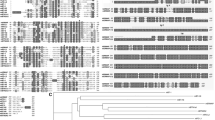Abstract
Two distinct murine cell-surface differentiation antigens, Mac-1 and LFA-1 (lymphocyte function-associated antigen 1), are compared here and shown to be related at the molecular level. Mac-1, defined by the M1/70 rat anti-mouse monoclonal antibody (MAb), is expressed on macrophages, natural killer cells and 50% of bone marrow cells, but not on B or T lymphocytes1–3. In contrast, the LFA-1 antigen, defined by the M7/14 rat anti-mouse MAb, is expressed on B and T lymphocytes and 75% of bone marrow cells, but not on thioglycollate-induced peritoneal exudate macrophages4,5. MAb blocking studies suggest that LFA-1 participates in T-lymphocyte-mediated killing and T-lymphocyte antigen-specific responses4,5. Mac-1 and LFA-1 have α-polypeptide chains of 170,000 and 180,000 molecular weight (Mr), respectively, and both contain β polypeptides of 95,000 Mr. This similarity prompted us to investigate their relationship. Mac-1 and LFA-1 have distinct cellular distributions, MAb-defined antigenic determinants and α-subunits, but have highly homologous or identical β-subunits as shown by tryptic peptide mapping. Moreover, they share some common antigenic determinants recognized by a polyclonal antiserum. Cross-linking studies show that in each antigen the subunits are noncovalently associated in α1β1 structures. Mac-1 and LFA-1 comprise a novel family of two-chain leukocyte differentiation antigens.
Similar content being viewed by others
References
Springer, T., Galfre, G., Secher, D. S. & Milstein, C. Eur. J. Immun. 9, 301–306 (1979).
Springer, T. A. & Ho, M-K. in Hybridomas in Cancer Diagnosis and Treatment (eds Mitchell, M. S. & Oettgen, H. F.) 35–46 (Raven, New York, 1982).
Holmberg, L. A., Springer, T. A. & Ault, K. A. J. Immun. 127, 1792–1799 (1981).
Davignon, D., Martz, E., Reynolds, T., Kürzinger, K. & Springer, T.A. Proc. natn. Acad. Sci. U.S.A. 78, 4535–4539 (1981).
Davignon, D., Martz, E., Reynolds, T., Kürzinger, K. & Springer, T. A. J. Immun. 127, 590–595 (1981).
Kürzinger, K. et al. J. Immun. 127, 596–602 (1981).
Springer, T. A. J. biol. Chem. 256, 3833–3839 (1981).
Strominger, J. L. et al. in The Role of the Major Histocompatibility Complex in Immuno-biology (ed. Dorf, M. E.) 115–172 (Garland STPM, New York, 1981).
Davis, M. M., Kim, S. K. & Hood, L. Cell 22, 1–2 (1980).
Greenwood, F. C., Hunter, W. M. & Glover, J. S. Biochem. J. 89, 114–122 (1963).
Elder, J. H., Pickett, R. A. II, Hampton, J. & Lerner, R. A. J. biol. Chem. 252, 6510–6515 (1977).
Author information
Authors and Affiliations
Rights and permissions
About this article
Cite this article
Kürzinger, K., Ho, MK. & Springer, T. Structural homology of a macrophage differentiation antigen and an antigen involved in T-cell-mediated killing. Nature 296, 668–670 (1982). https://doi.org/10.1038/296668a0
Received:
Accepted:
Issue Date:
DOI: https://doi.org/10.1038/296668a0
- Springer Nature Limited
This article is cited by
-
The role of integrins in inflammation and angiogenesis
Pediatric Research (2021)
-
General structural features that regulate integrin affinity revealed by atypical αVβ8
Nature Communications (2019)
-
The role of CD15-(Lex)-related carbohydrates in neutrophil adhesion
The Histochemical Journal (1992)
-
Tumor cell lysis by activated human neutrophils: Analysis of neutrophil-delivered oxidative attack and role of leukocyte function-associated antigen 1
Inflammation (1991)





